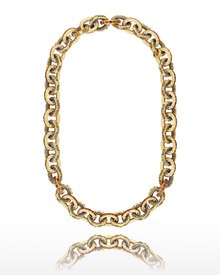

Fine metal chains are used in jewellery to encircle parts of the body, namely the neck, wrists and ankles, and they also serve as points to hang decorative charms and pendants. Unlike industrial or chains for other purposes, jewellery chains or body chains are designed for aesthetic purposes.
YouTube Encyclopedic
-
1/3Views:447 70225 89337 207
-
Jewellery How to make a rope chain by hand
-
3 Chain Links for Jewellery Making
-
How Chain For Jewelry Is Really Made
Transcription
Material
Jewellery chains are typically made from precious metals, mainly gold and silver. Platinum, palladium and steel may also be used. These metals are used because they are not very reactive, keep both their intricate shape and their strength, and require only minimal maintenance to keep their shine. Small lever mechanisms called findings serve as fastenings to enable the chain to be undone and redone.

Styles
-
Trace: A simple style of chain with small, uniform circular or oval links. Trace chains are typically very delicate, especially in finer widths.
-
Rolo: The links of a rolo chain are usually identical and often round. These links joined in a simple alternating sequence.
-
Singapore: This may also be called twisted curb, but the links are joined in such a way that, even when the chain is untwisted, there is always a natural curve to it. Usually this chain is sold very fine and has a liquid-like look to it.
-
Rope: Rope chain creates the effect of two twisting strands spiraled together, created by many small links which are not completely joined. One disadvantage of this otherwise strong chain is that, when one link does break, the rest of the chain might follow in succession.
-
Figaro: Figaro is not really a style but a very popular variation. A number of standard links (usually three) precede an elongated link all the way through. This variation can be replicated by many of the styles mentioned.
-
Wheat: Wheat chain is formed of very long, thin teardrop-shape links that all point in the same direction. The join of each link is like a tiny hinge, meaning this style is not as flexible or liquid-like as some others
-
Byzantine: The Byzantine chain is an intricate design in which each link is connected to four other links, creating a woven appearance.
-
Twisted link chain
-
Foxtail chain
-
A curb chain is when the links interlock with each other when laid flat. Some more open-link curb chains can only be distinguished from a trace by this method. This style of chain has the greatest variety of widths available, from a few millimetres to over four centimetres.
-
Briolette: Also known as Box, briolette is similar to a belcher chain except the links are tighter together and are square in shape, hence the name.
-
Brick link chain, also called a Boston link chain.
- Belcher: This is similar to the trace, a belcher chain link is wider than its thickness. Generally the links are round, but the shape of the link can vary.
- Prince Of Wales: This chain consists of a twisting chain made of small circular links, where each single link has no less than four others joining into it.
- Spiga: Spiga is formed of small figure-eight links which form a 3D chain that feels almost square, and looks as though the wire has been plaited.
- Anchor: The anchor chain copies the style of the chain that holds large anchors on ships, an oval link with a dividing bar through the middle. The interlinking sections may be of a curb or trace style. Also a version called Maritime where only every other link is an anchor link.
- Snake: Snake chain is a very tight-linked chain that has a round or square cross-section and has links that create a slight zigzag look.
- Bead: Bead chain is formed of small balls of metal joined by small lengths of wire, not longer than each bead in between. Also has its own 'snap over the first link' fastening. Larger steel versions are more often used to hold ID cards than in jewellery, but finer ones may be found for the purpose.
- Fancy: A "fancy" chain can be anything; any form of fine metal that can be replicated and joined onto each other to make a chain. Many fancy chains are variations of the standard styles, for example a trace chain formed of heart-shaped links or a curb chain with every other link set with a gemstone.








